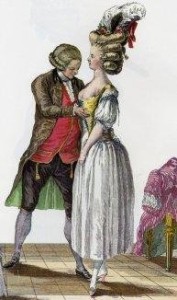I found an intriguing article on the Historic Royal Palaces blog, The Making of the Modern Bra.
We know that women made little home-made linen or cotton bodices to lift and define their breasts for the new-style dresses. There was no elastic and no underwiring as yet, so these women cut and shaped the fabrics they had to hand, and used lacing to pull the fabric in for extra hold … for a brief time, at the turn of the 19th century, there was a little golden age of home-made undergarments that can claim to being the first British bras as we know them today.
The article claims that staymakers were caught by surprise at the fashion revolution of the 1790s when the line, fit, and even the fabrics of gowns took a radical turn. Thus women took it upon themselves to cobble together undergarments that would work–essentially what New York socialite Mary Phelphs Jacobson did in 1913 when she needed something to wear under a (somewhat?) transparent evening gown. She used handkerchiefs, lace and cord, and patented the item a year later. I have to admit that bra research gets a bit murky as someone named Marie Tucek patented her “breast supporter” in 1893.
So the questions of the day:
- Did late Georgian staymakers have to scramble to catch up with fashions, and
- where are the extant early handmade “bras”?
To the first question, I say no. I don’t think they did. Any smart staymaker would have been keeping his/her eye on what was going on with les francais. I did a search on the Bath Chronicle archives (1770-1800), which are part of the astonishing Bath Archives, a fantastic timesuck research source. I searched on staymakers and found that business seemed to be booming, if not downright cutthroat in July of 1792:
13 Aug 1789 Fashion: Mr F Albrecht, French staymaker, 12 Miles Court, just returned from London with newest fashions of stays, corsets & riding stays.
26 Jul 1792 Employment: 8 journeyman staymakers required by a Master of Bath, London wages offered. Wm Driver, French staymaker, Trim Gate, Borough Walls
5 Jul 1792 Fashion: 8 journeyman staymakers wanted immediately, London wages, apply to several Masters in Bath. Will be protected from molestation & obstruction by previous employees. Fra. Allwright, French staymaker, Green St, Bath
19 Jul 1792 Employment: journeyman staymakers wanted – by several Masters in Bath, London wages. They will prosecute those inclined to obstruct those inclined to serve. H Tanton, French staymaker, 1 Quiet St on behalf of the Masters. Also apprentice wanted.
26 Jul 1798 Fashion: Francis Troei, staymaker (successor to Mr Loons) 18 Union Psge [Bath] has newest fashions in stays, corsets and new invented corset “la garlisle”. Orders Mr Philpot, perfumer, Bristol or Mrs Philpot, Hotwells
21 Nov 1799 Fashion: Geo Sykes, staymaker of 10 Abingdon Bldgs, Northampton St, Bath has the newest fashions executed to satisfaction. Good home-made stays for servants & working women 1 guin/pr. Sykes also carries on an umbrella manufactory
I included that last one because I thought it was interesting that the enterprising Mr. Sykes branched out into umbrellas, a natural expansion with whalebone and canvas to hand, and that he was making ready-made stays for working women. In another ad in the previous year he warned patrons that his 1-guinea stays were available for “ready money only.”
So calling costume historians. Should our heroines sit at home embroidering their own brassieres? Maybe they did; there’s a reference in a short story by Mrs. Gaskell that claims it was fashionable to make your own shoes at the turn of the century too, but I’ve never found it referenced elsewhere (but then I’ve never really looked). And unless staymakers included some sort of identifying label or mark, and the genteel amateurs embroidered their initials into their garments, how would we tell?
And what is a corset “la garlisle?”


We know some women made their own stays (there’s a “sampler” example in the Platt Hall collection that has different embroidery patterns, her name, and the date on it). But I am personally doubtful that anyone with the money to have a pair made would bother to make them, they’re not easy to pattern and are even harder to fit.
Interesting that there are some around, but I’m surprised the article didn’t cite them!
Stays were worn in the Regency period but they were different from the 18th century stays we are used to. They featured shaped gussets for the breasts and a stiff busk inserted between them for the separation so admired. women also wore a petticoat bodice, with a short stay ( or brassiere if you like) attached to a petticoat. Gowns also had a brassiere-like feature attached to the inside of the bodice sometimes, that was pinned across to support the bosom before buttoning up or tying the gown. They weren’t real brassieres as we know them, which did not come in until the late 1910s. As always, very young women sometimes did not wear any support at all, and the older, less slim ladies continued to wear their 18th century stays under the new gowns. Hope this is helpful!
Thanks! I’d love to see pics of those stays within petticoats/within gowns–can you point me to a source? All the stays I’ve seen in real life or in pics rely on canvas (or another hefty cotton) and whalebone; the real difference is that Regency era stays support but don’t shape or squeeze. I have a historically correct corset based on ca. 1810 and it’s very comfortable.